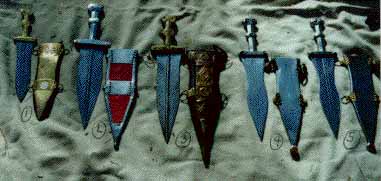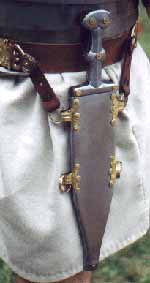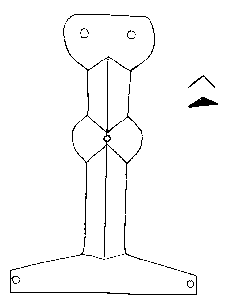

PUGIO 1/31/13
 |
 |
| Throughout the period
the outline
of the hilt remained basically the same. It was made with 2
layers
of horn or wood sanwiching the tang, each overlaid with a thin metal
plate.
The hilt plates were almost always iron, often thin sheet but sometimes
solid--see cross sections at far right. There is apparently no
evidence
that the hilt plates were ever cast out of brass or bronze, as on many
reproductions. Occasionally the hilt was decorated with engraving
or inlay. Note that the hilt is 3-1/2" to under 5" long overall
and that the
grip is quite narrow--it will always seem to be too small, and even the
solid iron ones will not be very heavy. It is possible that some rod-tang daggers had hilts which were entirely organic, with no iron plates, but only one ivory grip has survived (compare to numerous gladius hilt parts!). Also note the distinctive "hour-glass" shape of the center swell--it is the natural result of the slightly domed or conical swell being intersected by "gabled" grip. A similar effect is seen at the pommel and guard. Photos of original
pugiones are at http://www.romancoins.info/MilitaryEquipment-pugio.html.
|
 |
Scabbards
In the 1st century BC pubio
scabbards
were constructed much like sword scabbards: wood covered with leather,
in a metal frame with decorated metal panels. Early in the 1st
century
AD, 2 new types of scabbard came into use, known for convenience as
type
A and type B.
Type A had a metal shell
consisting
of a front and back plate with the edges worked over and soldered
together.
Inside was a wood or leather liner. Four suspension loops were
held
on by driving small nails through the shell and the liner, and
clenching
them over in back.
Type B scabbards were
leather-covered
wood, with a metal plate fastened to the front by the same nails which
secured the suspension loops.
Presumably there were leather thongs or tabs on the suspension
rings which tied or "buttoned" to the frogs on the balteus.
The type A scabbard disappeared
after c. 50 AD, but the type B continued in use.
Most type A and B scabbards
were
made with iron plates, and most of those which have been published are
inlaid, type A with enamel and either brass or silver (or tin), type B
with just silver or tin. The scabbard of the Leeuwen dagger is
brass,
decorated with lines of raised dots. These are usually
reconstructed
as repousse (punched from the back), but are acually cast in thin
strips
and soldered to the scabbard plate, according to Sebastiaan Berntsen of
the Gemina Project, who has
examined
the original closely. There is also a brass sheath decorated with
groups of engraved parallel lines. It is possible that many
dagger
scabbards were not decorated at all, but few plain scabbards have been
published.
Construction
Making a pugio can be difficult,
since the blade must have the proper shape, with either a simple or
grooved
midrib.
The flat tang matches the outline
of the hilt, and is sanwiched between 2 "organic" layers: wood, horn,
bone,
or ivory. Each layer can be several pieces (for guard, grip, and
pommel), often pinned or riveted through the tang. On some
examples
the tang ends at the pommel, so there is a solid organic block in that
space instead of 2 layers. Finally the thin iron (steel) plates
are
laid over the organic layers and riveted in place, with 2 or 4 rivets
through
the guard, 2 or 3 through the pommel, and occasionally one through the
center swell. The rivet heads can be decorative (even inlaid),
and
some have small dished washers under them.
The contours of the hilt
plates--approximately
matched by the organic layers--are often quite pronounced, but
reproductions
can be more conservative. The effect can be achieved by a shallow
ridge down the middle of the grip and another along the guard, plus
chiselled
accents and some slight dishing out of the pommel and center swell.
For rod-tanged blades, the handle
is assembled separately (with a solid organic piece or several), and
the
tang inserted into a hole through the length of the handle. It is
either held simply by friction, or by allowing the tang to project
beyond
the pommel and peening it flat.
Manning Imperial in
Australia makes a good pugio, just be sure to specify steel instead of
brass for the hilt and scabbard.
Mark Morrow also makes an
excellent pugio blade, as shown above.
Deepeeka makes the only
acceptable
"off the shelf" dagger, though it has minor problems: #3264B Brass
Beaded Pugio. It is a reasonable copy of the Leeuwen dagger,
though the scabbard is simply
embossed (like most repros), whereas on the original the dots are cast
in strips and soldered on. The scabbard may need an insert of
wood
or leather to keep the blade from rattling. The grip is a little
too wide, and the way the hilt plates at the ends of the guard wrap
around and overlap is badly done (and may not be correct anyway).
The blade is often VERY blunt, and the midrib is too large.
Overall, we rate this pugio as acceptable, though it can be improved
with relatively simple modifications (as shown above).
Also see the Suppliers page.
------------------------
Deepeeka's #3264E Pugio
Embossed is no longer on the "acceptable" list,
unfortunately.
The method of decorating the scabbard by riveting 4 incised brass
plates to the front is not found on any known original.
There are other minor problems (like the Brass Beaded version), but
that is the fatal flaw.
Deepeeka's #3264R "Royal" pugio
is definitely unacceptable--colored enamel was not used in that way,
certainly not
on a first century dagger. Their older pugio, #3264, is also
unusable,
as is anything Museum Replicas/Windlass calls a pugio. See page
of Things
to Avoid.